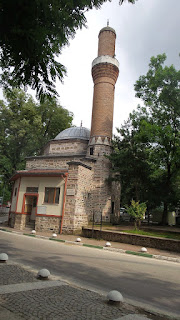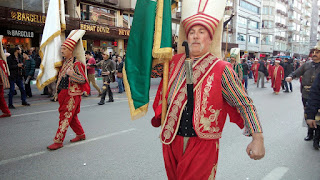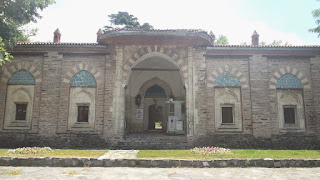HÜDAVENDİGAR I. MURAD CAMİİ
 Hüdavendigar külliyesinin merkez yapısı olan cami hüdavendigar şanıyla anılan I.Murad (1360-1389) tarafından 1366 yaptırılmıştır ''I'' planlı (tabhaneli zaviyeli) camilerden olan yapı Osmanlı mimarisinde cami ve medresenin aynı yapı içerisinde iki katlı olarak tasarlandığı tek yapıdır . Taş tuğla ve sivri kemerleriyle dikkat çeken yapıda Bizans dönemi sütun ve sütun başlıkları kullanılmış olup ; yapımında Bizanslı sanatkarların da görev aldığı bilinmektedir. Alt kat; son cemaat yeri, dış sofa, tek kubbeli merkezi alan ile altı odadan olmuşmaktadır. 19. Yüzyılda inşa edilen şadırvanı, merkezi alanın ortasındadır.Cami girişindeki sahanlığın iki yanındaki merdivenlerle çıkılan medresede, dört adet müderris ve muid (müderris yardımcısı) ile on iki adet öğrenci hücresi yer alır. Medresede, Molla Gürani , Zenbilli Ali Efendi , Tacizade Cafer Çelebi gibi şeyhülislamlık da yapmış ünlü kişiler müderrislik yapmıştır. I. Murad Camii çevre düzenlemesi 2013-2014 yıllarında Bursa Büyükşehir Belediyesi tarafından yaptırılmıştır. 2014 yılında UNESCO Dünya Mirası olarak ilan edilen alan içerisinde yer almaktadır.
Hüdavendigar külliyesinin merkez yapısı olan cami hüdavendigar şanıyla anılan I.Murad (1360-1389) tarafından 1366 yaptırılmıştır ''I'' planlı (tabhaneli zaviyeli) camilerden olan yapı Osmanlı mimarisinde cami ve medresenin aynı yapı içerisinde iki katlı olarak tasarlandığı tek yapıdır . Taş tuğla ve sivri kemerleriyle dikkat çeken yapıda Bizans dönemi sütun ve sütun başlıkları kullanılmış olup ; yapımında Bizanslı sanatkarların da görev aldığı bilinmektedir. Alt kat; son cemaat yeri, dış sofa, tek kubbeli merkezi alan ile altı odadan olmuşmaktadır. 19. Yüzyılda inşa edilen şadırvanı, merkezi alanın ortasındadır.Cami girişindeki sahanlığın iki yanındaki merdivenlerle çıkılan medresede, dört adet müderris ve muid (müderris yardımcısı) ile on iki adet öğrenci hücresi yer alır. Medresede, Molla Gürani , Zenbilli Ali Efendi , Tacizade Cafer Çelebi gibi şeyhülislamlık da yapmış ünlü kişiler müderrislik yapmıştır. I. Murad Camii çevre düzenlemesi 2013-2014 yıllarında Bursa Büyükşehir Belediyesi tarafından yaptırılmıştır. 2014 yılında UNESCO Dünya Mirası olarak ilan edilen alan içerisinde yer almaktadır.
MURAD I, THE SOVEREIGN MOSQUE
 This mosque, which is the central structure of the ''Hudevendigar Kulliye'' , was built in 1336 by Murad I called '' Hudavendigar'', or ''The Sovereign'' (1360-1389) The structure, wich is one of those mosques (with guestrooms and prayer sections), whic has a ''I'' shaped plan, is the only structure within Ottoman architecture designed as a two-floor building, inciuding both a mosque and a madrasah in the same buillding. İn the structure, wich stirekes attention with its stone and brick decorations and its pointed arches, columns and capitals of the Byzantine period are used. It is known that craftsmen from Byzantium were also involved in its construction. The ground floor consists of a portico fot late comers, a outer hall, a central area which is covered with a single dome, and of six rooms. Its shadirwan, or ablution fountain, built in the 19th century is located in the middle of the central area. In the madrasah , which is accessed by staircases locates on both sides of the stair head in the entrance of the mosque, there are four cells for the ''muderris'', or madrasah teachers, and the ''muid'', or deputy madrasah teacher, as well as twelve disciple cells. Well-known presons such as Molla Gurani, Zennibli Ali Efendi, and Tacizade Cafer Çelebi, were teachers in this madrasah, who also performed the duty of ''Sheikh ul-Islam'' (the chief religious offical in the Ottoman Empire) Murad Mosque landscaping desing was completed by Bursa Metropolitan Municipality in 2013-2014 Located in the site whic was inscribed on the UNESCO World Heritage List in 2014.
This mosque, which is the central structure of the ''Hudevendigar Kulliye'' , was built in 1336 by Murad I called '' Hudavendigar'', or ''The Sovereign'' (1360-1389) The structure, wich is one of those mosques (with guestrooms and prayer sections), whic has a ''I'' shaped plan, is the only structure within Ottoman architecture designed as a two-floor building, inciuding both a mosque and a madrasah in the same buillding. İn the structure, wich stirekes attention with its stone and brick decorations and its pointed arches, columns and capitals of the Byzantine period are used. It is known that craftsmen from Byzantium were also involved in its construction. The ground floor consists of a portico fot late comers, a outer hall, a central area which is covered with a single dome, and of six rooms. Its shadirwan, or ablution fountain, built in the 19th century is located in the middle of the central area. In the madrasah , which is accessed by staircases locates on both sides of the stair head in the entrance of the mosque, there are four cells for the ''muderris'', or madrasah teachers, and the ''muid'', or deputy madrasah teacher, as well as twelve disciple cells. Well-known presons such as Molla Gurani, Zennibli Ali Efendi, and Tacizade Cafer Çelebi, were teachers in this madrasah, who also performed the duty of ''Sheikh ul-Islam'' (the chief religious offical in the Ottoman Empire) Murad Mosque landscaping desing was completed by Bursa Metropolitan Municipality in 2013-2014 Located in the site whic was inscribed on the UNESCO World Heritage List in 2014.
 Hüdavendigar külliyesinin merkez yapısı olan cami hüdavendigar şanıyla anılan I.Murad (1360-1389) tarafından 1366 yaptırılmıştır ''I'' planlı (tabhaneli zaviyeli) camilerden olan yapı Osmanlı mimarisinde cami ve medresenin aynı yapı içerisinde iki katlı olarak tasarlandığı tek yapıdır . Taş tuğla ve sivri kemerleriyle dikkat çeken yapıda Bizans dönemi sütun ve sütun başlıkları kullanılmış olup ; yapımında Bizanslı sanatkarların da görev aldığı bilinmektedir. Alt kat; son cemaat yeri, dış sofa, tek kubbeli merkezi alan ile altı odadan olmuşmaktadır. 19. Yüzyılda inşa edilen şadırvanı, merkezi alanın ortasındadır.Cami girişindeki sahanlığın iki yanındaki merdivenlerle çıkılan medresede, dört adet müderris ve muid (müderris yardımcısı) ile on iki adet öğrenci hücresi yer alır. Medresede, Molla Gürani , Zenbilli Ali Efendi , Tacizade Cafer Çelebi gibi şeyhülislamlık da yapmış ünlü kişiler müderrislik yapmıştır. I. Murad Camii çevre düzenlemesi 2013-2014 yıllarında Bursa Büyükşehir Belediyesi tarafından yaptırılmıştır. 2014 yılında UNESCO Dünya Mirası olarak ilan edilen alan içerisinde yer almaktadır.
Hüdavendigar külliyesinin merkez yapısı olan cami hüdavendigar şanıyla anılan I.Murad (1360-1389) tarafından 1366 yaptırılmıştır ''I'' planlı (tabhaneli zaviyeli) camilerden olan yapı Osmanlı mimarisinde cami ve medresenin aynı yapı içerisinde iki katlı olarak tasarlandığı tek yapıdır . Taş tuğla ve sivri kemerleriyle dikkat çeken yapıda Bizans dönemi sütun ve sütun başlıkları kullanılmış olup ; yapımında Bizanslı sanatkarların da görev aldığı bilinmektedir. Alt kat; son cemaat yeri, dış sofa, tek kubbeli merkezi alan ile altı odadan olmuşmaktadır. 19. Yüzyılda inşa edilen şadırvanı, merkezi alanın ortasındadır.Cami girişindeki sahanlığın iki yanındaki merdivenlerle çıkılan medresede, dört adet müderris ve muid (müderris yardımcısı) ile on iki adet öğrenci hücresi yer alır. Medresede, Molla Gürani , Zenbilli Ali Efendi , Tacizade Cafer Çelebi gibi şeyhülislamlık da yapmış ünlü kişiler müderrislik yapmıştır. I. Murad Camii çevre düzenlemesi 2013-2014 yıllarında Bursa Büyükşehir Belediyesi tarafından yaptırılmıştır. 2014 yılında UNESCO Dünya Mirası olarak ilan edilen alan içerisinde yer almaktadır.MURAD I, THE SOVEREIGN MOSQUE
 This mosque, which is the central structure of the ''Hudevendigar Kulliye'' , was built in 1336 by Murad I called '' Hudavendigar'', or ''The Sovereign'' (1360-1389) The structure, wich is one of those mosques (with guestrooms and prayer sections), whic has a ''I'' shaped plan, is the only structure within Ottoman architecture designed as a two-floor building, inciuding both a mosque and a madrasah in the same buillding. İn the structure, wich stirekes attention with its stone and brick decorations and its pointed arches, columns and capitals of the Byzantine period are used. It is known that craftsmen from Byzantium were also involved in its construction. The ground floor consists of a portico fot late comers, a outer hall, a central area which is covered with a single dome, and of six rooms. Its shadirwan, or ablution fountain, built in the 19th century is located in the middle of the central area. In the madrasah , which is accessed by staircases locates on both sides of the stair head in the entrance of the mosque, there are four cells for the ''muderris'', or madrasah teachers, and the ''muid'', or deputy madrasah teacher, as well as twelve disciple cells. Well-known presons such as Molla Gurani, Zennibli Ali Efendi, and Tacizade Cafer Çelebi, were teachers in this madrasah, who also performed the duty of ''Sheikh ul-Islam'' (the chief religious offical in the Ottoman Empire) Murad Mosque landscaping desing was completed by Bursa Metropolitan Municipality in 2013-2014 Located in the site whic was inscribed on the UNESCO World Heritage List in 2014.
This mosque, which is the central structure of the ''Hudevendigar Kulliye'' , was built in 1336 by Murad I called '' Hudavendigar'', or ''The Sovereign'' (1360-1389) The structure, wich is one of those mosques (with guestrooms and prayer sections), whic has a ''I'' shaped plan, is the only structure within Ottoman architecture designed as a two-floor building, inciuding both a mosque and a madrasah in the same buillding. İn the structure, wich stirekes attention with its stone and brick decorations and its pointed arches, columns and capitals of the Byzantine period are used. It is known that craftsmen from Byzantium were also involved in its construction. The ground floor consists of a portico fot late comers, a outer hall, a central area which is covered with a single dome, and of six rooms. Its shadirwan, or ablution fountain, built in the 19th century is located in the middle of the central area. In the madrasah , which is accessed by staircases locates on both sides of the stair head in the entrance of the mosque, there are four cells for the ''muderris'', or madrasah teachers, and the ''muid'', or deputy madrasah teacher, as well as twelve disciple cells. Well-known presons such as Molla Gurani, Zennibli Ali Efendi, and Tacizade Cafer Çelebi, were teachers in this madrasah, who also performed the duty of ''Sheikh ul-Islam'' (the chief religious offical in the Ottoman Empire) Murad Mosque landscaping desing was completed by Bursa Metropolitan Municipality in 2013-2014 Located in the site whic was inscribed on the UNESCO World Heritage List in 2014.


















































